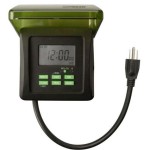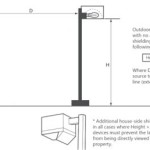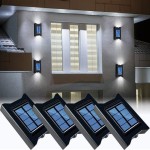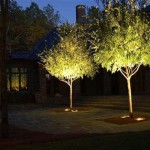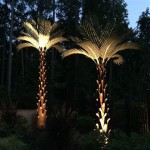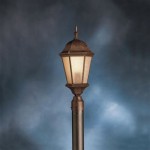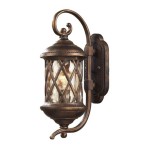How Bright Does An Outdoor Light Need To Be?
Outdoor lighting serves a variety of purposes, from illuminating pathways and driveways to enhancing the aesthetics of a property. The brightness of an outdoor light, measured in lumens, is a crucial factor that determines its effectiveness and impact. Choosing the right brightness level requires considering the specific application, desired ambiance, and safety concerns.
Factors Affecting Outdoor Light Brightness
Several factors influence the appropriate brightness for an outdoor light. These include:
- The size of the area to be illuminated: A larger area requires a brighter light source to ensure adequate coverage. For instance, a large driveway or backyard might need a high-lumen fixture, while a smaller patio or walkway could be adequately illuminated with a lower-lumen option.
- The purpose of the lighting: Security lights often necessitate higher lumen outputs to deter intruders, while decorative lights may prioritize ambiance and atmosphere. For pathways and driveways, a balance between visibility and aesthetics is usually desired.
- The surrounding environment: A light's effectiveness is influenced by ambient light levels. In areas with high ambient light, such as urban settings, a brighter light source may be needed to create a noticeable impact.
- The distance of the light source from the area to be illuminated: The farther away the light source, the more lumens are required to provide adequate illumination. For instance, a porch light located close to the entrance will generally require fewer lumens than a floodlight mounted higher up on a building.
Recommended Lumen Ranges for Common Outdoor Applications
The following table provides recommended lumen ranges for various common outdoor lighting applications:
| Application | Recommended Lumen Range | |-----------------------------------------|------------------------| | Pathway Lighting | 100-500 lumens | | Driveway Lighting | 200-1000 lumens | | Patio Lighting | 100-500 lumens | | Security Lighting | 500-2000 lumens | | Landscape Lighting | 50-200 lumens | | Street Lighting | 1000-5000 lumens | | Floodlighting for Building Facades | 1000-10,000 lumens |These are general guidelines, and the actual lumen requirements may vary depending on the specific circumstances. It is always advisable to consult with a lighting specialist for personalized recommendations.
Choosing the Right Bulb Type
Beyond the lumen output, the type of light bulb also plays a crucial role in outdoor lighting effectiveness. Common bulb types for outdoor applications include:
- Incandescent bulbs: While relatively inexpensive, incandescent bulbs are inefficient and produce a warm, yellowish light. They are generally not recommended for safety or energy-saving purposes.
- Halogen bulbs: These bulbs offer brighter light than incandescent bulbs but are also less energy-efficient. They are often used for security lighting due to their powerful output.
- Fluorescent bulbs: These bulbs are more efficient than incandescent and halogen bulbs, providing a cool, bluish light. They are often used in streetlights and other large-scale outdoor lighting applications.
- LED bulbs: LED bulbs are the most energy-efficient option, offering long lifespans and a wide range of color temperatures. They are becoming increasingly popular for outdoor lighting due to their versatility and environmental benefits.
The choice of bulb type will depend on factors such as energy efficiency, desired light color, and budget.
Ensuring Optimal Outdoor Lighting
To ensure optimal outdoor lighting, consider the following tips:
- Proper placement: Position lights strategically to illuminate the desired areas effectively. For example, pathway lights should be placed along the sides of the path, while driveway lights should be mounted high enough to illuminate the entire area.
- Appropriate shielding: Use fixtures with shields to prevent glare and light pollution. This minimizes discomfort and improves the overall aesthetic of the outdoor space.
- Motion sensors: Consider using motion sensors for security lighting to activate lights only when necessary, maximizing energy efficiency and reducing light pollution.
- Timer settings: Use timers to automatically switch lights on and off, reducing energy consumption and promoting safety.
- Regular maintenance: Periodically clean and inspect lights to ensure optimal performance and longevity.
By carefully considering the factors discussed above, homeowners and property managers can choose the right brightness level for their outdoor lighting needs, ensuring safety, security, and aesthetic appeal.

Choose The Best Color Temperature For Your Outdoor Lighting Knowledge Base Super Bright Leds

What Is The Best Led Color Temperature For Outdoor Lighting

Best Color Temperature For Outdoor Lighting Enhanced

How Bright Should Landscape Lighting Be

How Many Lumens Are Needed For Outdoor Lighting The Home Depot

How Many Lumens Do You Need For Outdoor Lighting Gamasonic Usa

How Bright Should My Outdoor Lighting Be

How Bright Is Too For Outdoor Lighting Resort Inc

How Many Lumens Are Needed For Outdoor Lighting The Home Depot

A Bright Idea For Outdoor Lighting Ina Country
Related Posts

